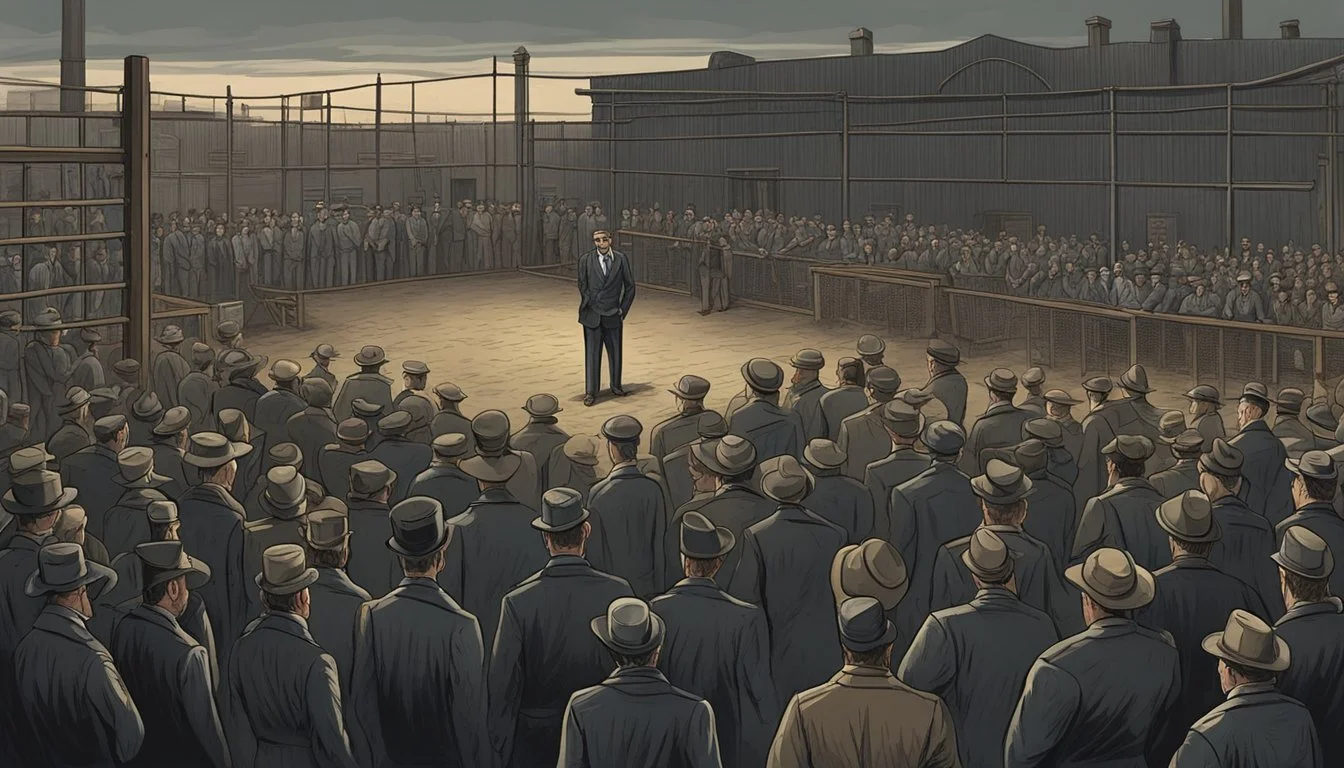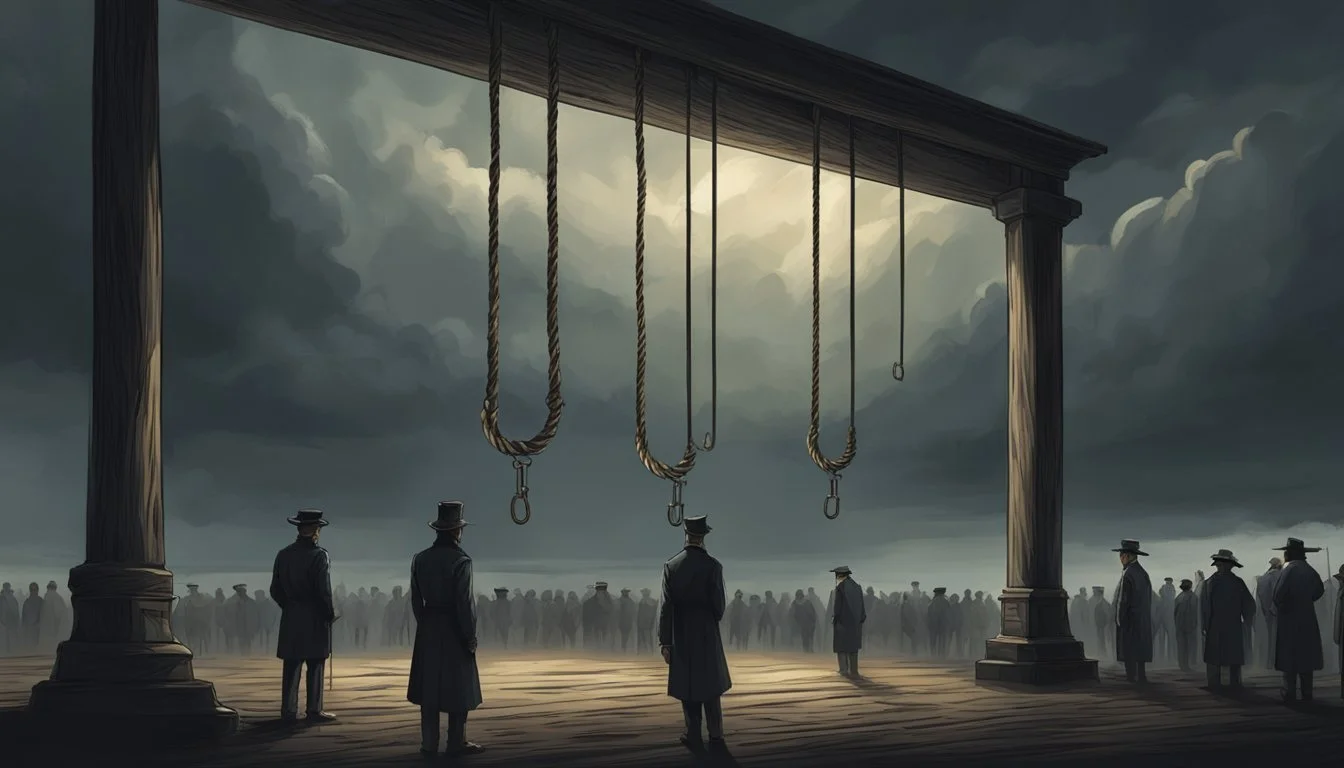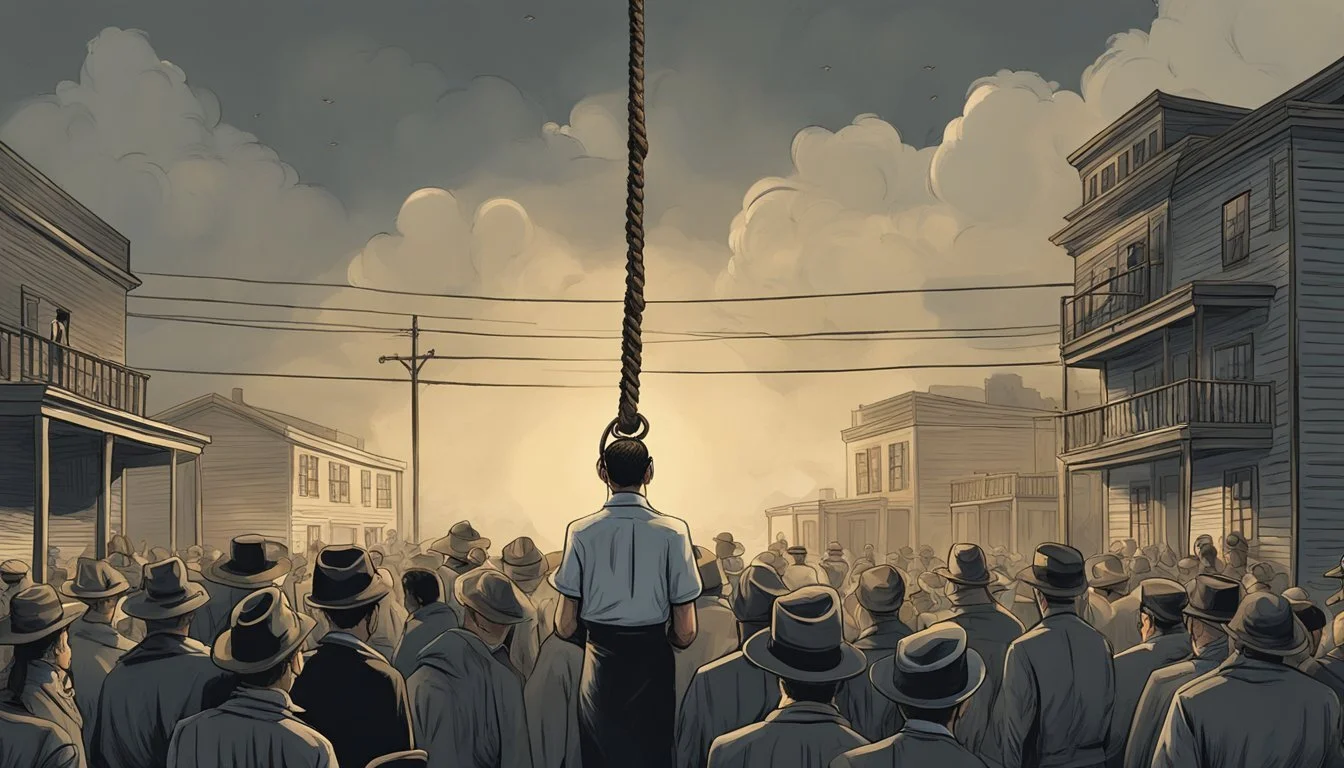Carl Panzram's Defiant Last Words: America's Most Repulsive Criminal Hanged
A Chilling End to a Brutal Legacy
Carl Panzram, one of America's most notorious serial killers, left an indelible mark on criminal history with his chilling final words. On September 5, 1930, as he faced execution by hanging, Panzram defiantly addressed his executioner: "Yes, hurry it up, you Hoosier bastard! I could kill a dozen men while you're fooling around!"
This unrepentant statement encapsulated the brutality and cold-bloodedness that defined Panzram's criminal career. Born in 1891 to Prussian immigrants, Panzram embarked on a path of violence that included murder, rape, arson, and burglary. His crimes spanned across the United States, leaving a trail of destruction in his wake.
Prior to his execution, Panzram confessed to 21 murders and over 1,000 acts of sodomy. His lack of remorse and the sheer scale of his atrocities earned him the moniker of "America's most repulsive criminal." Despite the horrific nature of his actions, Panzram's story continues to captivate true crime enthusiasts and psychologists seeking to understand the depths of human depravity.
Early Life and Origins
Carl Panzram's youth was marked by poverty, abuse, and a descent into criminal behavior. His experiences shaped him into one of America's most notorious serial killers.
Troubled Childhood
Carl Panzram was born on June 28, 1891, in Minnesota. He grew up in a poor family with six siblings. His parents, East Prussian immigrants, struggled to provide for their children.
Panzram endured physical abuse from his father and older brothers. At age 8, he was caught stealing at school. This incident led to severe beatings at home.
By 11, Panzram began drinking alcohol regularly. He ran away from home multiple times to escape the violence and neglect. These early traumas likely contributed to his later criminal behavior.
The Minnesota State Training School
At age 11, Panzram was sent to the Minnesota State Training School for Boys. This reformatory aimed to rehabilitate troubled youth through strict discipline and hard labor.
Panzram experienced further abuse at the school. He claimed staff members sexually assaulted him. The harsh conditions included beatings, isolation, and forced labor.
Rather than reform Panzram, the school seemed to intensify his anger and criminal tendencies. He learned new criminal skills from other inmates. After his release at 14, Panzram's criminal career escalated rapidly.
Criminal Career
Carl Panzram's criminal career spanned decades and escalated from petty theft to horrific acts of violence. His extensive rap sheet included burglary, arson, assault, and multiple murders across the United States.
Initial Offenses
At age 11, Panzram committed his first known crime by stealing cake, apples, and a revolver from a neighbor. This incident led to his placement at the Minnesota State Training School. By 14, he was incarcerated at Montana State Reform School for burglary.
Panzram's early crimes focused on theft and property destruction. He burglarized hundreds of homes and businesses, often setting fires to cover his tracks. His targets ranged from private residences to government buildings.
Between stints in various reform schools and prisons, Panzram drifted across the country. He supported himself through robbery, forgery, and other illicit means.
Violent Evolution
Panzram's crimes grew increasingly violent over time. He began assaulting his robbery victims, often targeting men and boys. By his own account, he raped over 1,000 males during his criminal career.
His first known murder occurred in 1920. Over the next decade, Panzram claimed to have killed 21 people. His victims included:
Children as young as 11
Fellow inmates
Random strangers
Panzram showed no remorse for his actions. He viewed his crimes as revenge against a society he despised. His rage only intensified with each arrest and imprisonment.
In 1928, Panzram was caught burglarizing a home in Washington D.C. This final arrest led to his execution in 1930, ending his decades-long reign of terror.
Notable Crimes and Incarcerations
Carl Panzram's criminal career spanned decades and continents, leaving a trail of destruction in his wake. His offenses ranged from petty theft to horrific acts of violence, with multiple prison stays punctuating his reign of terror.
Burglary and Theft
Panzram's criminal activities began with burglary and theft. He targeted homes, businesses, and even military installations. In 1907, he broke into a Minnesota National Guard armory, stealing weapons and ammunition. This incident led to his first major incarceration at the Minnesota State Training School.
His most audacious theft occurred in 1922 when he robbed former U.S. President William Howard Taft's home in New Haven, Connecticut. Panzram stole jewelry, bonds, and a handgun that he later used in murders.
Murder Spree
Panzram's violence escalated to murder in the 1920s. He claimed to have killed 21 people, though only a handful were confirmed. His victims were often young men or boys whom he sexually assaulted before killing.
In 1922, Panzram purchased a yacht with stolen money. He lured sailors aboard, raped and murdered them, then dumped their bodies at sea. He boasted of killing ten victims this way.
In Africa, Panzram allegedly murdered six men during an expedition. He shot and killed a man in Salem, Massachusetts, for which he was arrested in 1928.
Attempted Escapes
Panzram's time behind bars was marked by violent behavior and escape attempts. At Oregon State Penitentiary, he planned an elaborate escape but was caught with hacksaw blades hidden in his shoe.
In 1928, while incarcerated at Washington D.C. jail, Panzram escaped by sawing through cell bars. He was recaptured after two days of freedom.
His final imprisonment at Leavenworth Federal Penitentiary saw him in solitary confinement due to his dangerous nature. Despite the heightened security, Panzram continued to pose a threat, killing a prison laundry foreman in 1929.
International Crimes
Carl Panzram's criminal activities extended far beyond U.S. borders. His life on the run took him to various countries, where he continued his spree of violence and theft. In Africa, Panzram committed some of his most heinous acts.
Life on the Run
Panzram fled the United States in 1920 to evade capture. He stowed away on a ship bound for Europe, eventually making his way to various African countries. In each location, he left a trail of destruction.
Panzram robbed and assaulted countless victims across the continent. He claimed to have murdered 10 people during his time in Africa. His crimes included violent attacks, rapes, and thefts targeting both locals and fellow travelers.
The Angola Exploit
In 1921, Panzram arrived in Luanda, Angola. He posed as an oil prospector to gain access to remote areas. Over several weeks, Panzram raped and murdered at least six local boys.
He also robbed multiple villages, stealing money and valuables. Panzram later boasted of burning down a missionary compound during this period. His ruthless violence in Angola stood out even among his long list of atrocities.
After amassing stolen goods, Panzram fled to Lisbon. There, he continued his criminal activities before eventually returning to the U.S.
The Psychology of a Killer
Carl Panzram's criminal mind reflected deep-seated psychological issues and a nihilistic worldview. His actions and words revealed a complex interplay of mental health problems and a profound contempt for human life.
Mental Health Analysis
Panzram exhibited clear signs of antisocial personality disorder. This condition manifested in his lack of empathy, disregard for social norms, and impulsive behavior. His childhood experiences of abuse and neglect likely contributed to the development of this disorder.
Experts suggest Panzram may have also suffered from other mental health issues. These potentially included depression, post-traumatic stress disorder, and substance abuse problems. His time in various prisons and reform schools exposed him to further violence and abuse, exacerbating his psychological troubles.
Nihilistic Beliefs
Panzram's worldview was characterized by extreme nihilism. He rejected all moral principles and believed human life held no inherent value. This philosophy fueled his brutal crimes and lack of remorse.
In his writings, Panzram expressed a deep hatred for humanity. He viewed people as inherently selfish and corrupt. This belief system allowed him to justify his violent actions as merely reflecting the true nature of human existence.
Panzram's nihilism extended to himself. He showed no desire for redemption or change, embracing his role as a violent criminal. This mindset persisted until his execution, reflected in his defiant final words.
Capture and Final Incarceration
Carl Panzram's reign of terror came to an end in 1928. His arrest led to a trial and imprisonment at Fort Leavenworth, where he would face execution for his heinous crimes.
Arrest and Trial
Panzram's capture occurred after a burglary in Washington, D.C. Police found stolen items in his possession, linking him to the crime. During interrogation, he confessed to multiple murders and other violent acts.
His trial was swift. Panzram represented himself and openly admitted his guilt. He showed no remorse for his actions, instead expressing disdain for the legal system and humanity in general.
The court found Panzram guilty and sentenced him to 25 years in Leavenworth Federal Penitentiary.
Fort Leavenworth's Last Stand
At Leavenworth, Panzram's violent behavior continued. He killed a fellow inmate, Robert Warnke, in 1929. This act led to a death sentence.
Panzram welcomed his impending execution. He refused all appeals and expressed eagerness for his punishment.
On September 5, 1930, Panzram faced the gallows. His final words were defiant and chilling: "Yes, hurry it up, you Hoosier bastard! I could kill a dozen men while you're fooling around!"
At 6:30 am, the execution was carried out, ending the life of one of America's most notorious criminals.
Panzram's Legacy
Carl Panzram's impact extends beyond his crimes, influencing literature, criminal psychology, and cultural discourse on extreme criminality. His autobiography and correspondence provide rare insights into the mind of an unrepentant killer.
Henry Lesser and the Panzram Papers
Henry Lesser, a prison guard, formed an unlikely connection with Panzram. He provided the condemned man with writing materials, enabling Panzram to pen his autobiography. This manuscript became known as the Panzram Papers.
Lesser safeguarded these writings for decades. In 1970, he published them as "Killer: A Journal of Murder." The book offered a raw, uncensored look into Panzram's life and psyche.
The Panzram Papers reveal disturbing details about his crimes and his contempt for humanity. They also shed light on the brutal conditions in early 20th century prisons and reformatories.
Cultural Impact
Panzram's story has fascinated true crime enthusiasts and researchers for generations. His case is often cited in discussions about nature versus nurture in criminal behavior.
Several books and documentaries have explored Panzram's life. These works examine his troubled childhood, criminal career, and defiant attitude towards society and death.
Panzram's legacy serves as a dark chapter in American history. It raises questions about the justice system, rehabilitation, and the limits of human depravity.
His story continues to be studied by criminologists and psychologists. It provides valuable insights into extreme antisocial behavior and the potential consequences of systemic abuse.
Critique of the Correctional System
Carl Panzram's experiences and writings shed light on the systemic issues plaguing the American prison system in the early 20th century. His scathing criticism, coupled with modern perspectives, reveals deep-rooted problems that persist to this day.
Panzram's Criticism
Panzram's autobiographical accounts exposed the brutal conditions in correctional facilities. He described rampant violence, corruption, and inhumane treatment at various institutions, including Reform School and Sing Sing Correctional Facility.
The harsh environment, according to Panzram, only served to harden criminals rather than rehabilitate them. He argued that the system created a cycle of violence, turning petty offenders into hardened criminals.
Panzram's writings highlighted the lack of educational and vocational programs in prisons. This absence of opportunities for personal growth and skill development left inmates ill-equipped for life after release.
Contemporary Perspectives
Modern criminologists and social reformers have echoed many of Panzram's criticisms. They point to overcrowding, inadequate mental health services, and a focus on punishment over rehabilitation as ongoing issues.
Studies show that harsh prison conditions often lead to increased recidivism rates. This data supports Panzram's assertion that the system fails to address the root causes of criminal behavior.
Efforts for prison reform now emphasize:
Education and job training programs
Mental health support
Alternatives to incarceration for non-violent offenders
Improved living conditions
These initiatives aim to break the cycle of crime and promote successful reintegration into society. While progress has been made, many argue that fundamental changes to the correctional system are still necessary.
In the Words of Panzram
Carl Panzram left behind chilling writings that provide insight into his twisted mind. His autobiographical works and reflections reveal a man devoid of remorse for his heinous crimes.
Reflective Writings
Panzram penned disturbing reflections during his incarceration. He wrote, "In my lifetime I have murdered 21 human beings, I have committed thousands of burglaries, robberies, larcenies, arsons and, last but not least, I have committed sodomy on more than 1,000 male human beings. For all these things I am not in the least bit sorry."
His unapologetic stance shocked readers. Panzram expressed contempt for humanity, declaring, "I wish you all had one neck and that I had my hands on it." These writings exposed the depths of his hatred and lack of empathy.
Memoirs and Autobiographical Content
Panzram's autobiography, later published as "Killer: A Journal of Murder," detailed his life of crime. He recounted his abusive childhood, criminal exploits, and time in various prisons. The memoir was written on contraband writing materials provided by a sympathetic guard.
His frank admissions included graphic descriptions of murders and other atrocities. Panzram wrote about his global crime spree, claiming victims across multiple continents. The autobiography ended shortly before his execution on September 5, 1930, providing a disturbing self-portrait of one of America's most ruthless criminals.









